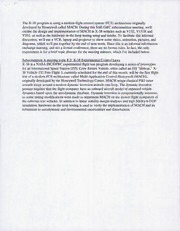
NASA Technical Reports Server (NTRS) 20000039385: X-38 Experimental Controls Laws PDF
Preview NASA Technical Reports Server (NTRS) 20000039385: X-38 Experimental Controls Laws
\ 1 4 " The X-38 program is using a modem flight control system (FCS) architecture originally developed by Honeywell called MACH. During this SAE G&C subcommittee meeting, we'll outline the design and implementation of MACH in X-38 vehicles such as V132, V131R and V201, as well as the hardware-in-the-Ioop testing setup and results. To facilitate this informal discussion, we'll use a VCR, laptop and projector to show some video, animation, pictures, and diagrams, which we'll put together by the end of next week. Since this is an informal information exchange meeting, and not a formal conference, there are no format rules. In fact, the only requirement is for a brief topic abstract for the meeting minutes, which I've included below. Subcommittee A meeting topic 8.3: X-38 Experimental Control Laws X-38 is a NASA JSCIDFRC experimental flight test program developing a series of prototypes for an International Space Station (ISS) Crew Return Vehicle, often called an ISS "lifeboat." X- 38 Vehicle 132 Free Flight 3, currently scheduled for the end of this month, will be the first flight test of a modem FCS architecture called Multi-Application Control-Honeywell (MACH), originally developed by the Honeywell Technology Center. MACH wraps classical P&I outer attitude loops around a modem dynamic inversion attitude rate loop. The dynamic inversion process requires that the flight computer have an onboard aircraft model of expected vehicle dynamics based upon the aerodynamic database. Dynamic inversion is computationally intensive, so some timing modifications were made to implement MACH on the slower flight computers of the subsonic test vehicles. In addition to linear stability margin analyses and high fidelity 6-DOF simulation, hardware-in-the-Ioop testing is used to verify the implementation of MACH and its robustness to aerodynamic and environmental uncertainties and disturbances.
